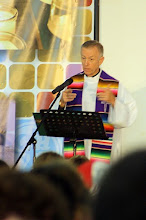 Today is the Memorial of two of the three great “Cappadocian” Fathers of the 4th century, Ss Basil and Gregory Nazianzen—friends and fellows standing in defense of the teaching of the Council of Nicaea (325 AD) on the full divinity of Christ and of the Holy Spirit. Their teaching, preaching and personal witness led to the confirmation of these beliefs at the Council of Constantinople (381 AD)—giving us the form of the “Nicene” Creed that we recite at Mass today. These men are regarded as two of the original four “Doctors of the Eastern Church”—along with Ss John Chrysostom and Athanasius.
Today is the Memorial of two of the three great “Cappadocian” Fathers of the 4th century, Ss Basil and Gregory Nazianzen—friends and fellows standing in defense of the teaching of the Council of Nicaea (325 AD) on the full divinity of Christ and of the Holy Spirit. Their teaching, preaching and personal witness led to the confirmation of these beliefs at the Council of Constantinople (381 AD)—giving us the form of the “Nicene” Creed that we recite at Mass today. These men are regarded as two of the original four “Doctors of the Eastern Church”—along with Ss John Chrysostom and Athanasius.How to describe the divinity of the Incarnate Word? The theologians of the late 3rd and early 4th centuries struggled over this question, striving to strike a balance between respect for the sovereign unity of the One God and the integrity of creation, along with the conviction that redemption in Christ must involve more than just the “approval” of God: it requires actual participation by God. So the idea that Christ was the most exalted and first made of all Creation was inadequate: Christ must be seen as sharing fully in divinity: He must be of the same ‘stuff’ as God: not created at all, but eternally begotten, ‘true God from true God.’ The word settled on at Nicaea to describe this was (in Greek) homo-ousios. What does this mean? It means (in its two parts) ‘of the same substance.’ A poor analogy: the marble quarry of Carrera in Italy is the same ‘stuff’ as Michelangelo’s David…
Folks in the Western part of the Roman Empire had pretty well given up Greek and embraced Latin as their common tongue. I will ignore the problems that arose as a result of linguistic mistakes, mistranslations and general suspicion, and I will simply refer to the word in Latin that is the equivalent of homo-ousios. It is con-substantialis. So you can see where our “new word” in the Creed that is causing so many tongues to trip up comes from!
Our older English version of the Creed, in its rendering, produced the phrase “one in being.” For all the decades since its introduction, it has been suspected of being inadequate at best, and misleading at worst. Again, I won’t go into the details of theology here (and you may thank me privately, later!). But the difficulty of the concept was what led those responsible for the new translation to opt for a “trans-planting” rather than a translation. I think their thinking was “Better safe than sorry”…
Basil and Gregory (along with Basil’s brother, St Gregory of Nyssa, the third of the “Cappadocians”) were vindicated in their insistence on the full divinity of the Lord, and our Faith has been based on their teaching (and its proper developments) ever since. So even though we don’t recite the Creed at Masses today, we might pray it in private, and give thanks to Ss Basil and Gregory Nazianzen for living out the courage of their convictions for the fullest teaching of the Church.
One small footnote: some Fathers of the Church at and after Nicaea rejected the Creed on the argument that the crucial term, homo-ousios, was not found in the Scriptures. This argument finally failed, and it is worth noting that from very early times the concept of sola Scriptura as commonly understood today was rejected.
Below is the Credo from Ralph Vaughn Williams' Mass in G-minor for your enjoyment--sung in Latin. Let the video fully load before starting it, to maximize your listening pleasure. And at about minute 1:06, notice how Vaughn Williams uses the music to express the meaning of consubstantial.

No comments:
Post a Comment